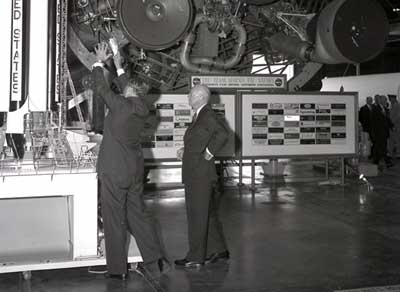Fifty years of US space policy: the more things change…by Taylor Dinerman
|
| Nearly fifty years later the document stands up pretty well. |
“Second, there is the defense objective for the development of space technology. We wish to be sure that space is not used to endanger our security. If space is to be used for military purposes, we must be prepared to use space to defend ourselves.” The 2006 US National Space Policy says essentially the same thing in a more convoluted and bureaucratic way: “The United States considers space capabilities—including the ground and space segments and supporting links—vital to its national interests. Consistent with this policy, the United States will preserve its rights, capabilities and freedom of action in space, dissuade or deter others from either impeding those rights or developing capabilities intended to do so; take those actions necessary to protect its space capabilities, respond to interference, and deny, if necessary, adversaries the use of space capabilities hostile to US national interests.” The publicly stated military goals laid out in 1958 are essentially indistinguishable from those of 2006.
“Third, there is the factor of national prestige. To be strong and bold in space technology will enhance the prestige of the United States among the peoples of the world and create added confidence in our scientific, technological, industrial and military strength.” Americans don’t like to talk much about this factor, but in the May 25th, 1961 speech that launched the Apollo program, John Kennedy said “I believe that this nation should commit itself to achieving the goal, before this decade is out, of landing a man on the moon and returning him safely to earth. No single space project will be more impressive to mankind…” This is still a factor in all the world’s space program’s notably the Chinese one.
“Fourth, space technology affords new opportunities for scientific observation and experiment which add to our understanding of the earth, the solar system and the universe.” This is still as true in 2007 as it was in 1958 and still, by itself, not enough of a reason to spend the relatively large sums of money that a serious space effort demands. One point that is mentioned in conjunction with the explorations of Mars is, “The cost of transporting men and materiel through space will be extremely high, but the cost and difficulty of sending information through space will be comparatively low.”
The statement also looks ahead to the military uses of space, which they describe as “broadly speaking in the fields of communications and reconnaissance.” We know that the Eisenhower administration had been hard at work on a spy satellite program before the Sputnik launch the fact that an official White House statement said that “It is certainly feasible to obtain reconnaissance information with a fairly elaborate instrument, information that could be relayed back to earth by radio.” Of course the early spy satellites used film that was returned to earth via capsules, but even so it is interesting to see that while the actual programs were kept secret, the ideas behind them were openly discussed.
| The unchanging nature of outer space itself—and the unchanging nature of human beings—may be what make this basic statement so valuable. |
The document also attempts to throw cold water on the idea of dropping bombs from satellites. Here the administration’s goal of calming a frightened public becomes evident. But the military part of the text makes clear that “…our military strength will grow naturally and surely.”
The team that signed this statement included such notable scientists and leaders as Hans Bethe, Detlev Bronk, Edwin Land, Jerome Wiesner, and James Doolittle, who all played important roles in the contentious political debates over space power from the 1960s to the 1980s. While the debates continue, US space policy is still largely guided by the statement they helped put together in 1958.
It may be that since the nature of the rockets used to get into space have not changed all that much since the days of Sputnik, a policy designed when America’s first ICBM, the Atlas, had not yet entered service may still provide useful guidance in the absence of a cheaper way to get into orbit. However, the unchanging nature of outer space itself—and the unchanging nature of human beings—may be what make this basic statement so valuable.
